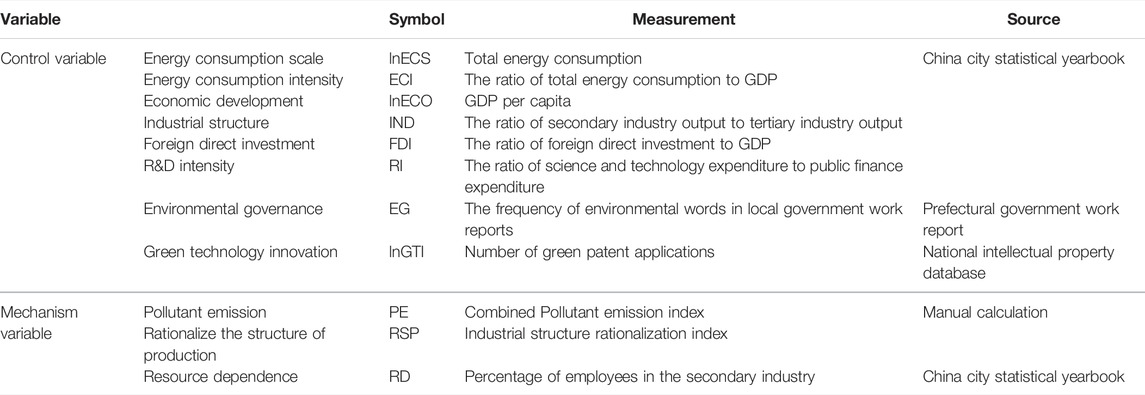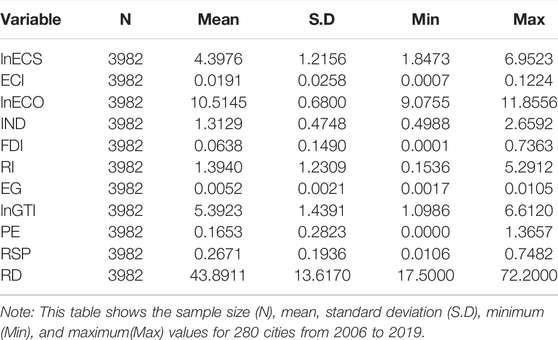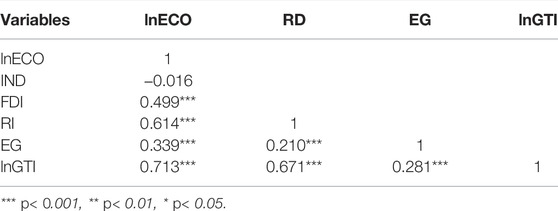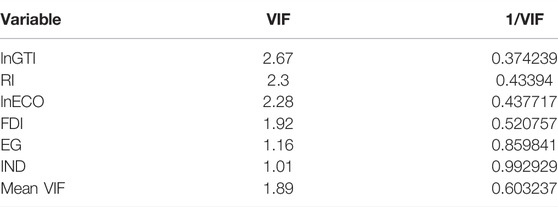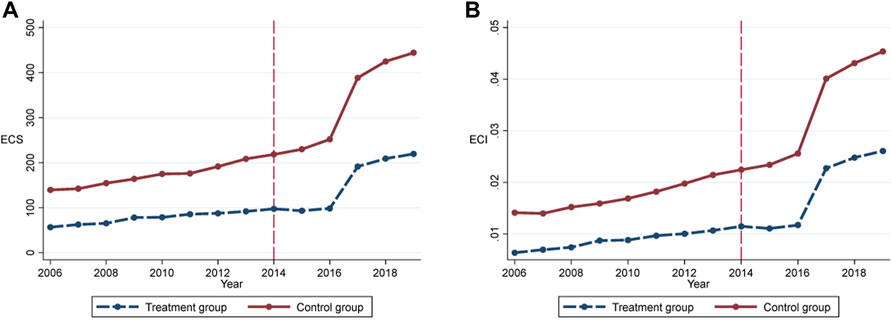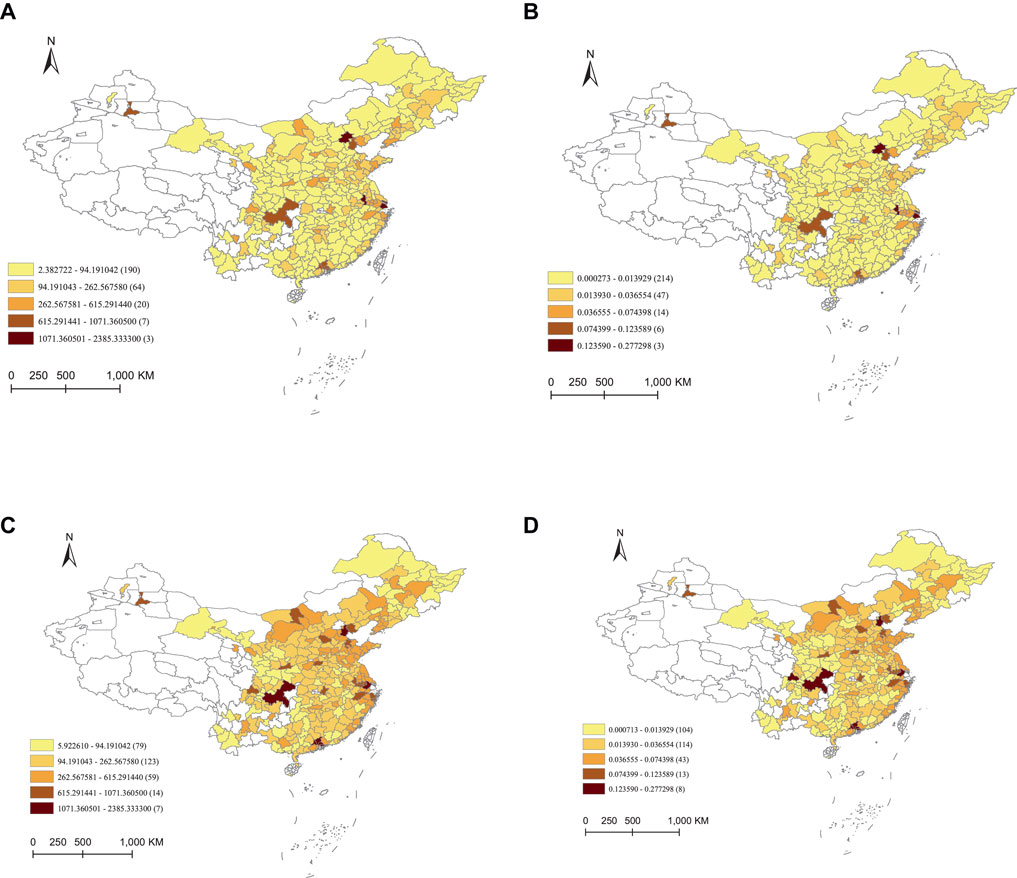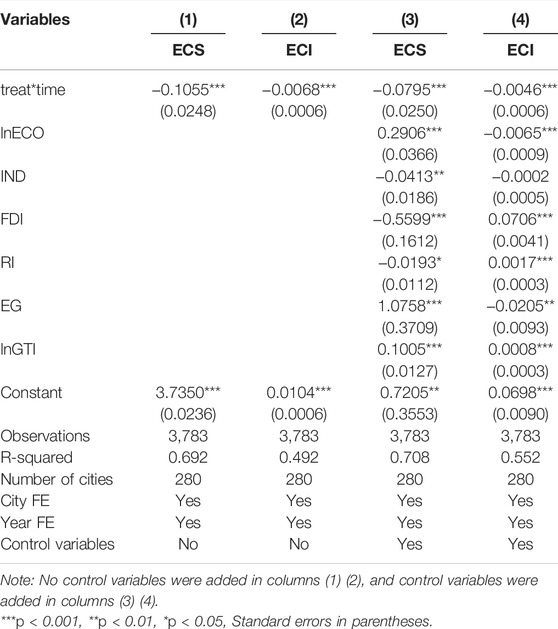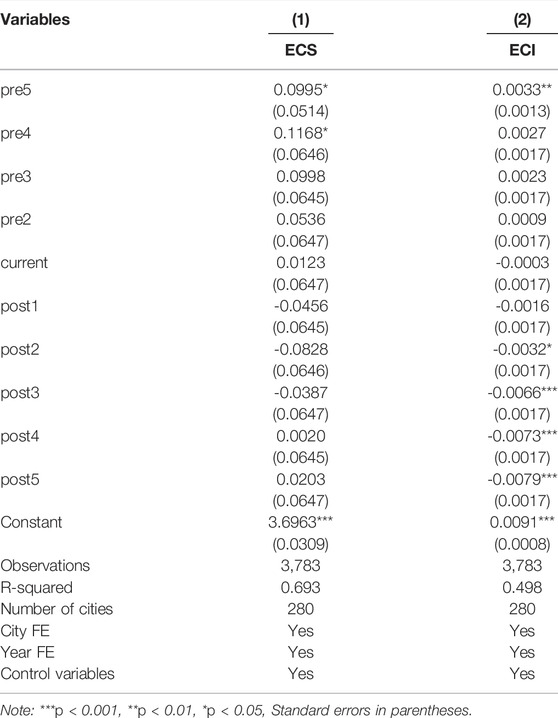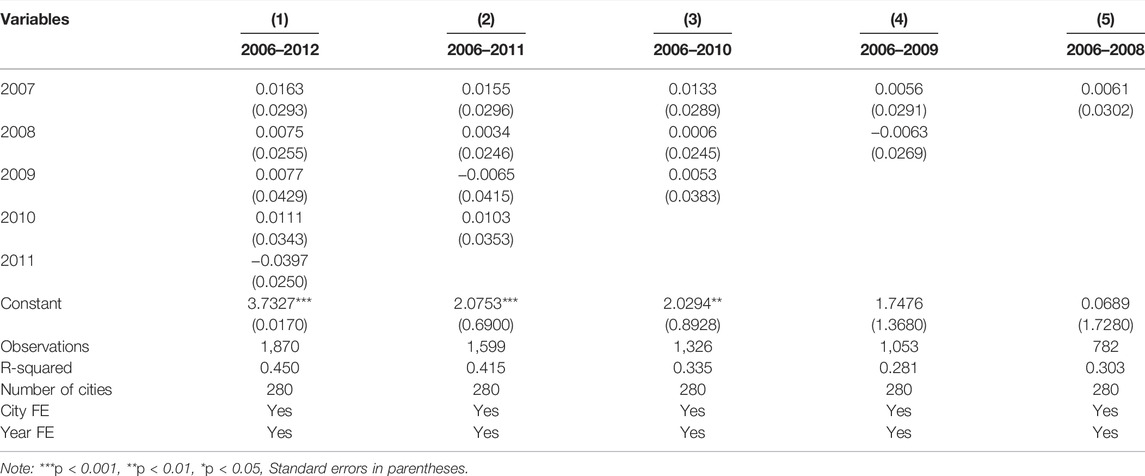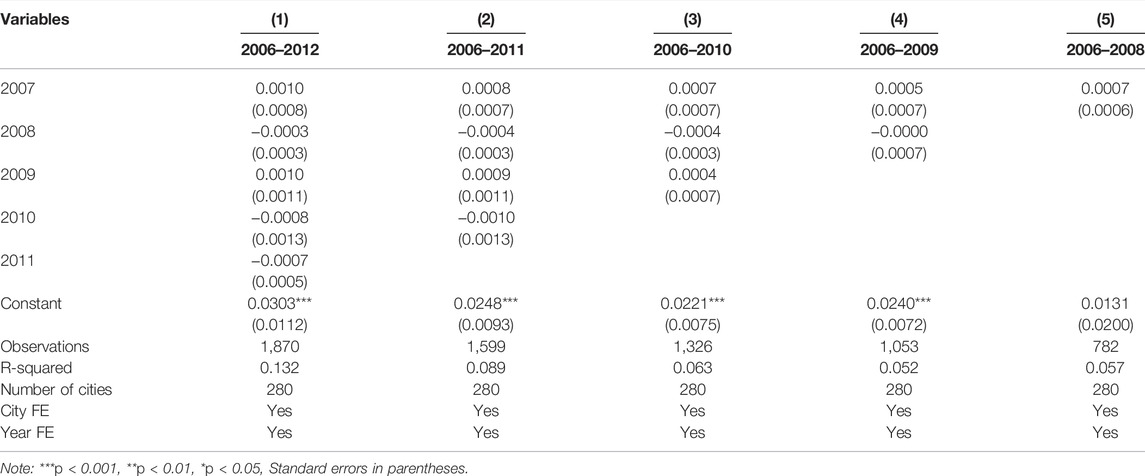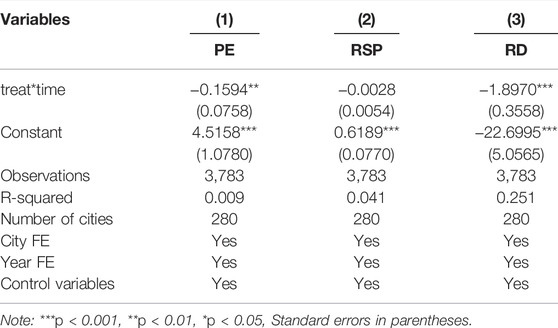- Business School, Shandong University of Technology, Zibo, China
Undoubtedly, resource-based cities (RBCs) have significantly contributed to the socio-economic development of China; however, energy consumption intensified due to this development. Reducing energy consumption in RBCs and transforming the energy structure of RBCs are major challenges. To promote the energy structure transformation of RBCs, the Chinese government has introduced the Sustainable Development Policy for Resource Cities (SDPRC), but the effectiveness of SDPRC is still unclear. Therefore, this study uses the difference-in-difference (DID) approach to explore the impact of SDPRC on energy consumption scale (ECS) and energy consumption intensity (ECI) in RBCs based on panel data of 280 cities from 2006 to 2019. Firstly, the empirical results indicate that the implementation of SDPRC significantly reduces energy consumption in RBCs. The findings unfold that the inverted U-shaped relationship between SDPRC and ECS, while the effect on ECI has a certain lag, which is significant from the second year, and its impact increases persistently with the advancement of the policy. The stability test also verifies our conclusion. Secondly, the heterogeneity results show that the effect of SDPRC implementation varies across RBCs in different regions and development stages. Thirdly, the impact mechanism test result shows that controlling pollutant emissions and getting rid of resource dependency are important ways to reduce energy consumption in RBCs. However, the implementation of SDPRC does not promote the rationalization and transformation of industrial structure in RBCs. Based on the findings, policy recommendations are proposed for energy transformation and sustainable development of RBCs.
1 Introduction
With the increasing energy demand and climate problems, the transformation and sustainable development of resource cities has become a contemporary issue worldwide. RBCs are cities where the exploitation and processing of natural resources such as minerals and forests are the leading industries (Martinez-Fernandez et al., 2012). The RBCs play a pivotal role in the economic development of an economy (Wang et al., 2022). Industrialization and rapid economic growth have led to resource depletion, air pollution, and ecological deterioration (Gonzalez-Garcia et al., 2018). Besides that, poor industrial structure, insufficient innovation, and low productivity of enterprises negatively affect economic growth (Ndlovu and Inglesi-Lotz 2020; Ahmad and Zheng 2021; Xing et al., 2021). The energy industry is the backbone of China’s economic development. China has become the world’s largest energy consumer, and the total energy consumption is still climbing (He et al., 2017). According to the Global Energy Statistics Yearbook 2020, China’s energy intensity is 1.15 higher than the United States, 1.62 than Japan, 1.75 than the European Union, and twice the world average. RBCs are predominantly responsible for higher energy intensity because of excessive reliance on natural resources, and conventional industrial structure leads to higher energy consumption and energy structure transformation difficulties, and other issues (Li S et al., 2021).
Some scholars recently proposed paths for RBCs transformation to promote sustainable development, such as increasing investment in renewable energy and low-carbon technologies, building a diversified energy structure, optimizing industrial structure, and actively promoting industrial extension and substitution (Jiao et al., 2020; Stephenson et al., 2021). In response to the critical situation in RBCs, the Chinese government has introduced a series of policies, among them the Sustainable Development Plan of Nation RBCs, 2013-202 (SDPRC hereafter) announced by the State Council in 2013. The main aim of this policy is to promote the transformation of the energy mix and sustainable development of RBCs. Although 7 years have passed since the SDPRC was enacted, the current literature is silent on how SDPRC impacted RBCs’ energy consumption and the mechanisms of its impact?
The common methods used in studies exploring policy effects include Synthetic Control Method (Chen et al., 2022), Difference in difference (Fang et al., 2021), Regression Discontinuity Design (Salti et al., 2022), and Instrumental Variable Methods (Caselli and Reynaud, 2020). The DID method explores the effect of policy implementation by capturing the difference in changes between the Treatment group and Control group before and after policy implementation, which can avoid endogeneity problems to a large extent and get more accurate results. Qiu et al. (2021) explored the impact of low-carbon city pilot policies on urban green total factor productivity; Zhang and Wang (2021) investigated the impact of carbon trading on economic output and carbon reduction in China’s industrial sector. Therefore, this study uses the DID method to investigate the impact of SDPRC on energy consumption in RBCs.
We consider the SDPRC as a quasi-natural experiment on the selected panel data of 280 cities from 2006to 2019. To do this, two-way fixed-effects regression using the DID method is employed to estimate the impact of SDPRC implementation on energy consumption in RBCs and performed the stability tests on the results to verify the findings. We explore the differences in the impacts of SDPRC implementation in different types of RBCs from two perspectives: spatial and developmental stages, explore the mechanisms of SDPRC impacts on energy consumption in RBCs, and finally propose targeted suggestions for the transformation and sustainable development of RBCs.
The remainder of this paper is structured as follows. Section 2 presents the literature review and policy background, Section 3 presents the methodology and data source, Section 4 comprises the results and discussion, Section 5 sums up the conclusion and policy implications.
2 Literature Review and Policy Ground
2.1 Literature Review
2.1.1 Studies on Resource-Based Cities
Research on RBCs is mainly divided into theoretical studies and transformation studies. Firstly, Lucas and Tepperman (1971) extended the four-stage theory by arguing that RBCs also go through the recession and closure stages. Based on these theories, Auty and Warhurst (1993) believe that RBCs have a resource curse phenomenon. He further highlighted that countries or regions with abundant natural resources would gradually lose the economic dividends and benefits from early resource extraction as the resources are depleted. The study on RBCs transformation has recently become a hot research topic among scholars. Xiao et al. (2021) measure the eco-efficiency of RBCs after the financial crisis by using a two-stage DEA model that includes both government and industrial sectors. The results show that eco-efficiency in RBCs is positive, and governance efficiency is positively associated with production efficiency. Likewise, Liu et al. (2021) used the improved TOPSIS method to assess the transformation effect of RBCs. Their findings show that the transformation efficiency of the vast majority of cities is between 0.4 and 0.8, and the transformation efficiency of all four economic regions is increasing, with the best transformation effect in the eastern region and the worst in the northeastern region. Yang et al. (2019) constructed a green development evaluation index system to assess the green development level (GDL) of mineral RBCs (MRBCs) from three perspectives, i.e., social, economic, and environmental. They concluded that the GDL of most MRBCs shows a good trend, but there are still 25% of cities whose performance is difficult to reach the expected effect, and the GDL of MRBCs shows significant variability between regions, decreasing from East to west. Long et al. (2013) integrated the intra- and inter-regional comparative advantages into a two-dimensional matrix model to select RBC alternative industries. The results show that stricter criteria correspond to a smaller total number of alternative industries. Taking Jiaozuo City as an example, rubber manufacturing, non-ferrous metal smelting, and machinery manufacturing have significant comparative advantages, and different types of RBCs should carry out industrial transformations according to their characteristics.
2.1.2 Studies on Energy Consumption
Concerning energy structure transformation research, Guilhot (2022) examined the energy policy over 40 years (1981–2020) in China. The results show that China’s energy policy before the 21 century focused on energy efficiency and energy security, while the current energy policy is more concerned with low-carbon energy transition and energy system diversification. Shahbaz et al. (2022) assessed the relationship between economic growth, research and development (R&D) spending, and energy consumption based on Chinese economic data from 1971 to 2018. Their empirical outcome disclosed a positive association between economic growth and energy consumption. However, there is a significant negative relationship between R&D expenditures and energy consumption. Similarly, Xin-gang and Jin (2022) explored the relationship between industrial restructuring, energy consumption, and economic growth at aggregated and decomposed levels using the least-squares and panel vector error models. The results showed that renewable energy consumption’s impact on economic growth is much lesser than coal and electricity consumption. Likewise, Amoako and Insaidoo (2021) examined the association between foreign direct investment (FDI) and energy consumption in Ghana from 1981 to 2014. The findings revealed that although FDI is positively correlated with energy consumption, FDI in Ghana has not yet resulted in energy-saving benefits.
2.1.3 Studies on Sustainable Development Policy
Likewise, SDPRC has attracted the attention of many scholars after its enactment. Fan and Zhang (2021) explored the impact of the policy on the transformation of RBCs after its implementation. The results showed that the program’s implementation caused a positive impact of 19.6, 55.4, and 74.5% on RBCs’ economic, social, and ecological transformation, respectively, but did not significantly impact the sustainable use of resources. Li Q et al. (2021) investigated the influence of the policy on the industrial transformation, and it was found that the implementation of SDPRC significantly reduced the share of secondary industry output in GDP and resource dependence in RBCs, and this impact was more significant in western cities.
2.1.4. Literature Gap
Although there has been an increasing number of studies on energy consumption in recent years, most have focused on the national and regional levels, and few studies have been conducted on energy consumption in resource-based cities. Due to the differences in research subjects and econometric techniques, there is no consensus on the impact aspects of energy consumption. At the same time, past studies on RBCs mainly focused on green development, industrial structure transformation, and eco-efficiency, but the research on energy-related issues in RBCs is still blank. In addition, no literature discusses the impact of SDPRC on energy consumption in RBCs. It would be more helpful to formulate corresponding policies for different stages to achieve synergistic governance in energy consumption.
Given the motivation of the study, this study contributes to the literature in the following ways. Firstly, this study explores the impact of SDPRC on energy consumption in RBCs using the DID method, which further enriches the relevant research on energy-related concerns in RBCs. Secondly, the impact mechanism of SDPRC on energy consumption in RBCs is explored from three perspectives: (1) pollution emission, (2) industrial institution rationalization, and (3) resource dependence. Thirdly, this study examines the impact of SDPRC on energy consumption scale (ECS) and energy consumption intensity (ECI) in RBCs from spatial and development stages perspectives to provide precise policy suggestions for the transformation of RBCs.
2.2 Policy Background
The transformation and sustainable development of RBCs has become a serious problem faced by many countries around the world, especially developing countries and emerging countries. Among them, China is experiencing rapid urbanization and industrialization. Thus, developing economic and social construction and ecological, environmental protection in a benign and coordinated manner has become an urgent problem in China. China’s RBCs are large in number and widely distributed. As important strategic bases for energy resources in China, they have contributed significantly to the economic and social development of China. However, the problems of unbalanced, uncoordinated, and unsustainable domestic economic development are prominent, and resource depletion and environmental problems are becoming increasingly severe. How to deal with the contradiction between resource development and ecological protection is the sustainable development of RBCs has become an urgent problem to be solved. To this end, the Chinese government has launched a series of policies and measures to promote green innovation in RBCs, including the SDPRC promulgated by the State Council 2013, which established a list 262 of RBCs. They classified them into growth cities (31), mature cities (141), declining cities (67), and regenerative cities (23) according to their characteristics and development stages. The policy establishes the general concept, objectives and guarantees measures for the sustainable development of RBCs. This consists of a pattern of coordination between urban resource development and economic and social development, ecological and environmental protection, and transforms the original economic development mode of resource cities, which relies excessively on resources and establishes a sound long-term mechanism to promote sustainable development RBCs.
3 Material and Methods
3.1 Method
DID is one of the most commonly used methods in recent years to investigate policy effects by capturing the differences in changes between the treatment and control groups before and after policy implementation (Qiu et al., 2021). To investigate the impact of SDPRC on energy consumption in resource cities, we construct the DID model as follows.
In Eq. 1, ECit indicates the energy consumption of i city in t year. We further divide ECit into energy consumption scale (ECS) and energy consumption intensity (ECI). treatit as an individual dummy variable representing the cities in the experimental group in t year as 1, and other cities as 0; timeit is a time dummy variable bounded by the year of policy implementation before implementation year is defined as 0, and other years are defined as1. Χit is a set of control variables with observable effects on energy consumption. The cross term treatit× timeit represents the dummy variable for RBCs after policy implementation, and its coefficient α1 is the core coefficient of interest, capturing the net effect of SDPRC on energy consumption. The policy treatment effect reflects the effect of policy on energy consumption in the treatment and control groups difference, and according to our hypothesis, this coefficient should be negative. There is a significant downward trend or slowdown in energy consumption growth rate in RBCs after the policy implementation. εit denotes the random error term. Because this paper is based on a panel dataset of cities, city fixed effects and time fixed effects are added to construct a two-way fixed effects model
In Eq. 2, ui and λt represent individual fixed effects and time fixed effects, respectively.
3.2 Description of Variables
3.2.1 Dependent Variable
There have been numerous studies on the determinants of energy consumption, and these studies used different proxies to measure energy use (Dingbang et al., 2021; Wang and Gong, 2022; Xue et al., 2022). By following the study of Feng et al. (2019), we calculated the energy consumption of cities as follows.
In Eq. 3, ECSi denotes the scale of urban energy consumption; ECi denotes the total amount of energy consumed in category i; ηi denotes the conversion factor of energy in category i into standard coal. The specific conversion coefficients of each type of energy and standard coal are shown in Table 1.
ECI is the main indicator reflecting energy consumption level and energy saving and consumption reduction and is used to examine the changes in economic structure and energy use efficiency. In this study, energy consumption per unit of GDP, the ratio of ECS to GDP, is used to measure energy intensity. In order to eliminate the effect of price fluctuations, GDP was deflated on a 2006 annual basis. Table 2 shows the measurements and sources of the variables.
3.2.2 Independent Variable
According to the list of RBCs published by SDPRC, we construct RBCs (109) as the treatment group and non-RBCs (171) as the control group. In this paper, the interaction term of the dummy city variable (Treat) and the policy variable (Time) is defined as the independent variable (Treat*Time). Treat is the city dummy variable, which is defined as RBCs by SDPRC as 1 and non-RBCs as 0; Time is the time dummy variable, and given that the year of SDPRC implementation is the end of 2013, the occurrence point of the policy is positioned 2014 as implementation year, before the year is defined as 0, and after the year is defined as 1.
3.2.3 Control Variable
According to existing studies (Shen et al., 2020; Fu et al., 2021), although DID method can solve part of the endogeneity problem. In order to reduce the estimation bias caused by omitted variables, the following variables were chosen to control the model.
Level of economic development (ECO). Many studies have demonstrated that economic growth is the essential driver of energy consumption and that the economic development of a city or region and energy consumption are closely related (Ahmad et al., 2021). Considering the differences in population size among cities, the logarithm of GDP per capita is used in this paper to measure economic development and to eliminate the effect of price fluctuations; GDP per capita is deflated on a 2006 annual basis.
Industrial structure (IND). Differences in industrial structure usually cause differences in energy consumption, and it is necessary to adjust the industrial structure, reduce the energy-intensive industrial structure, and achieve a positive interaction between industrial and energy structures (Carmona et al., 2017). The ratio of the tertiary industry to secondary industry represents the industrial structure. It is crucial that RBCs increase the proportion of tertiary industries and reduce the proportion of secondary industries, so the larger the ratio indicates that the industrial structure has been upgraded.
Foreign direct investment (FDI): Many studies have found that energy efficiency and emissions reduction can be expensive because of high R&D costs, more and more developing economies are considering FDI as an important tool to improve energy policies and develop emission reduction technologies (Amoako and Insaidoo, 2021). This paper uses the ratio of FDI to GDP to reflect the level of FDI.
R&D intensity (RI). It is widely believed that R&D activities are a vital factor influencing energy consumption. Therefore, this study uses the ratio of Science and Technology expenditure to public finance expenditure to reflect R&D intensity.
Environmental governance (EG): the different attitudes of local governments towards environmental governance often lead to different degrees of leniency in the introduction of policies, which in turn result in differences in local energy consumption. Concerning the study of Chen et al. (2018), the frequency of environment-related terms (low carbon, environmental protection, PM2.5, emission reduction, energy consumption) appearing in the work reports of prefecture-level municipal governments and their weight were selected to reflect the level of environmental governance of prefecture-level municipal governments.
Green Technology Innovation (GTI): As a key driver of sustainable economic development, green technology innovation plays an essential role in reducing energy consumption and advancing energy structure transformation, and the energy industry’s shift to innovation-driven development will be the future trend (Jiang et al., 2020). According to the International Patent Classification Green Inventory (IPC Green Inventory) classification number launched by WIPO in 2010, each city’s green patent application data are retrieved and used to measure green technology innovation.
3.2.4 Mechanism Variables
The following variables were selected to explore the path of SDPRC influencing energy consumption in RBCs.
Pollutant emission (PE): Fossil energy generates large amounts of SO2, soot, and other pollutants during the combustion process, and it has been well documented that the level of pollutant emission in a region is closely related to the level of energy consumption. In this paper, regarding Domazlicky and Weber (2004), the comprehensive pollutant emission index is chosen to measure the pollutant emission of each city.
1) The unit pollutant emissions of each city are linearly normalized. This paper mainly calculates three types of pollutants: wastewater, SO2, and soot.
Where UEij is the pollutant emissions per unit output value of pollutant j in city i, max(UEj) and min(UEj) are the maximum and minimum values of each indicator in all cities, and UEijs is the standardized value of the indicator.
2) The proportion of pollutant emissions varies greatly from city to city, and the intensity of emissions of different pollutants also varies greatly. The formula calculates the adjustment factor:
UEij is the city average of unit output emissions of pollutant j during the sample period.
3) Calculate the pollutant emission intensity of each city. PEi is the environmental regulation intensity of city i.
Rationalization of industrial structure (RSP): In the past, the rapid economic development of RBCs have relied on large inputs of production factors and large consumption of energy, and a series of unsustainable problems accompany such a development model, so the rationalization and transformation of the industrial structure of RBCs are essential to achieve sustainable economic growth. We use the index rationalization of industrial structure to measure the level of industrial structure rationalization of cities (Xin-gang and Jin, 2022). In this paper, we utilized the Thiel index to measure the degree of industrial structure rationalization of each prefecture-level city, which has the excellent property of measuring the structural deviation of different industries in terms of output and employment and the different economic status of each industry. The specific calculation formula is.
Where yi,m,t represents the proportion of regional GDP in period t of industry m in region i; li,m,t represents the proportion of industry m in region i in total employment in period t. The industrial structure Thayer index reflects the output value structure and employment structure of the three key industries. If the value is 0, the industrial structure is at the equilibrium level; if not 0. In terms of industrial structure, the industrial structure is unreasonable, and it is deviating from equilibrium.
Resource dependence (RD): Currently, the secondary industry is still the pillar industry on which RBCs rely for survival and development and is often used to measure the level of resource dependence, regarding Li Q et al. (2021). The proportion of employees in the secondary industry indicates the degree of resource dependence.
3.3 Data Source
The empirical analysis is conducted on the RBCs of China at the prefecture-level and above. Based on the data available, we utilize the panel data from 2006 to 2019 for 280 prefecture-level cities (109 RBCs and 171 non-RBCs) to assess the influence of sustainable development policies on energy consumption in RBCs. The data retrieved from China City Yearbook, China Statistical Yearbook, and Statistical Yearbooks of Cities, and the few missing data were interpolated to make up for them. To eliminate the effect of price fluctuations, GDP is deflated on a 2006 annual basis according to the price index of each province. In the empirical process, this paper take the natural logarithm of ECS, ECO, and GTI to attenuate the heteroskedasticity (Fan and Zhang, 2021). Descriptive statistics of the variables are shown in Table 3.
4 Empirical Results and Discussion
4.1 Variable Multicollinearity Test
Table 4 shows the results of correlations analysis. The outcome indicates that the maximum correlation coefficient is 0.713 (level of economic development and green technology innovation), and most of the variables have correlation coefficients less than 0.6. Therefore, the control variables do not have a strong correlation. Table 5 shows the results of the variance inflation factor (VIF) test. The maximum VIF value was 2.67 (lnGTI), which is much smaller than 10. Therefore, the multicollinearity of variables could be ignored.
4.2 Parallel Trend Test
Before using the DID method, the key step is to make a common trend assumption, which requires that ECS and ECI of the Treatment and Control groups have parallel trends before SDPRC. Figures 1A,B show the time trends of ECS and ECI from 2006 to 2019, respectively, and it can be seen from the figure that before the 2014 years, the Treatment group and Control group both had consistent trends in ECS and ECI. However, it is difficult to distinguish which category of cities has a greater impact on energy consumption by implementing the policy based on the time trend graph alone, which we will further discuss in the empirical evidence below.
In addition, Figure 2 show the spatial distribution of ECS and ECI of cities, (a), and (b) for ECS and ECI before the policy implementation (2006–2014), and (c), and (d) for ECS and ECI after the policy implementation (2015–2019), respectively. From the spatial distribution of ECS and ECI before and after the policy, we can see that the ECS and ECI of most cities are still on the rise in the 5 years after the policy, which may be because most cities are still in the development stage and still need a large amount of energy consumption to support the rapid economic development. At the same time, the spatial distribution map also reflects another problem: there are significant differences in ECS and ECI between cities. Furthermore, energy consumption varies significantly between cities in different geographic locations, which may affect our empirical results.
4.3 Baseline Regression Results
First, this study estimates the parameters of the benchmark model based on Eq. 2 using the DID method based on the panel data of 280 cities over 2006-2019, and Table 6 shows the regression results. It can be seen that the coefficients in columns (1)–(4) are all negative and significant at 1% level, indicating that the total ECS and ECI of RBCs decreased or slowed down after the implementation of SDPRC compared to non-RBCs. This result indicates that SDPRC is playing an important to reduce energy consumption and promoting energy structure transformation in RBCs.
The coefficients of ECO are significant at a 1% level with the values of 0.2096 and -0.0065. Numerically, a 1% increase in ECO leads to a 0.2906% increase in ECS and a 0.065% decrease in ECI. The reason may be that a large amount of energy consumption still accompanies the rapid economic development of the city, but the low-carbon transformation of the energy structure has been promoted in parallel, making the energy consumption intensity has gradually tended to be decoupled from the economic development, which is also consistent with the study of Tang et al. (2018).
The coefficients of IND are significantly negative with the values of -0.0413 and -0.0002. The results portray that optimizing industrial structure significantly reduces ECS, but the effect on ECI is not significant. It indicates that the focus of controlling energy consumption in RBCs in the future should still be on industrial structure adjustment and optimization. We also test the role of industrial structure rationalization in reducing energy consumption in the subsequent impact mechanism test.
The coefficients of FDI are -0.5599 and 0.0706, and both pass the significance test at the 1% level. ECS decreases 0.5599% when FDI goes up by 1% and an increase of 0.0706% in ECI. It indicates that as the level of FDI increases, the energy consumption of RBCs decreases, but the energy consumption intensity increases instead. These findings indicate that while expanding the scale of FDI, foreign and domestic enterprises do not adopt uniform energy conservation and emission reduction policies. It can be concluded that FDI is allocated towards energy-intensive industries. It caused a negative correlation between FDI and ECI. Our findings are in agreement with the findings of (Yue et al., 2011).
The results further show that for every 1% increase in RI, ECS decreases by 0.0193%, and ECI increases by 0.0017%. Referring to past studies (Huang et al., 2021), R&D investment intensity usually reduces total energy consumption by acquiring advanced energy-saving and emission-reducing technologies and equipment. The coefficient of ECS is negative, which is also the same as most previous studies conclude that the increase in RI reduces the scale of energy consumption. However, unlike the findings of past studies, the increase in RI leads to a simultaneous increase in ECI. Exploring the reason for this may be that resource-based urban industries are still dominated by steel and petrochemicals, and R&D intensity often fails to have a significant impact on these industries with high pressure on energy conservation and emission reduction and low production efficiency (Luan et al., 2019).
For every 1% increase in EG, ECS increases by 0.0758%, and ECI decreases by 0.0205%, indicating the current government program has reduced the ECI to some extent has not stopped the rising trend of energy consumption. Although the level of environmental governance is improving, it is not sufficient to offset the large amount of energy consumption brought about by the rapid development of the city; and there is often a lag between the formulation and implementation of policies, which leads to the fact that ECS is not significantly inhibited by environmental governance (WU et al., 2020).
The coefficients of lnGTI are 0.1005 and 0.0008, and both pass the significance level test. It indicates that green innovation does not mitigate energy consumption growth; contrary to green technology, innovation suppresses energy consumption in cities (Khattak et al., 2022). The reason for these findings may be because this paper chooses green invention patents to measure urban green technology innovation, and patents, as a form of green input, may have a certain lag from being converted into output.
4.4 Time Trend Analysis
To further explore the effect of SDPRC over time, we construct the dummy time variables pre(n) and post(n) before and after the policy, the policy implementation year 2014 as the base year: current, the pre-policy time dummy variable as pre(n) (n = 1,2,3,4,5), the post-policy time dummy variable as post(n) (n = 1,2,3,4,5) To eliminate the effect of policy lag, we exclude the pre1 and add the interaction term of the resource-based city dummy variable (treatit) and the time dummy variable to the model for regression. Table 7 represents the regression results.
When ECS is the dependent variable, the coefficients of the interaction term before the policy implementation (pre2-pre5) are positive. After the policy implementation (post1-post3), the interaction term coefficients are all negative but insignificant. The absolute values of the coefficients after the implementation are inverted U-shaped, reaching a maximum in the second year. The coefficients of post4 and post5 become positive again, indicating that the implementation of SDPRC did cause a small but insignificant decrease in ECS in RBCs. The effect reached best after 2 years, but the effect has disappeared since the fourth year after implementation.
When ECI is the dependent variable, the coefficients of the interaction terms are positive before the policy and negative after the implementation. The coefficients become significant from post2, and the absolute values increase year by year, indicating the policy lag’s impact on the ECI of RBCs after the implementation. The effect of policy implementation gradually improves over time, ECI is significantly inhibited by this compound.
4.5 Heterogeneity Test
The previous results show that SDPRC significantly reduces energy consumption in RBCs. To further explore the impact of SDPRC on energy consumption in RBCs, we examine the heterogeneity of RBCs, which may have heterogeneity in the impact of SDPRC implementation due to certain differences in geographic location and economic development level. Therefore, the paper explores the heterogeneity of their spatial differences and development stage differences.
4.5.1 Spatial Heterogeneity
Table 8 shows that all coefficients are negative except for the coefficient of energy consumption scale in the western region, which passed the significance test, indicating that the implementation of SDPRC has a certain degree of suppression effect on energy consumption in RBCs in the central and eastern regions.
When ECS is the dependent variable, the effect of SDPRC is more vigorous in East than Central and West regions (i.e., East > Central > West). However, when ECI is the dependent variable, the effect of SDPRC is strong in the East than in the West and Central regions (i.e., East > West > Central). It indicates that SDPRC has a more obvious effect on energy consumption reduction in the eastern region. On the one hand, cities in the central and western regions are inland, with closed transportation, backward innovation capacity, and brain drain, and urban development still relies on high-energy-consuming and high-polluting enterprises. Many traditional industries have outdated infrastructure and low productivity. Therefore, since the policy has been implemented, cities in the central and western regions still face problems such as lagging policy execution and difficulties in transformation. On the other hand, in the transformation of RBCs, because the policy implementation has brought an industrial transfer to central and western cities, most negative environmental externalities and pollution-induced welfare losses are borne by cities in the middle and west. This result agrees with the finding of Wang et al. (2022).
4.5.2 Growth-Stage Heterogeneity
SDPRC classifies RBCs into four types according to their resource security capacity and economic development stage: growing, mature, declining, and regenerating. Growing cities are in the rising stage of resource development, while Mature cities have a stable resource with a substantial resource security capacity. Declining cities deplete resources and have sharp conflicts between economic development and the ecological environment. Regenerating cities are gradually becoming less reliant on resources and stepping into the path of sustainable development. Therefore, the implementation of SDPRC may have heterogeneous impacts on RBCs in different development stages.
Table 9 shows the regression. The coefficients of the interaction terms are negative, and most of them are significant, except for the positive coefficient of the interaction term in column (1). The coefficient of the ECS in growing cities is positive, and the reason for this may be that growing cities are rapidly growing and are resources are still being developed. Therefore, the impact of policy does not offset the energy consumption required for rapid growth development. The coefficients of the interaction terms for the remaining three types of cities are all negative, implying that SDPRC has reduced the energy consumption of all three types of cities. The coefficients for mature cities are all negative and pass the significance test at the 1% level, indicating that SDPRC significantly reduces energy consumption in mature cities. The coefficient of the interaction term for declining cities is negative and high in absolute value, indicating that SDPRC suppresses the energy consumption of declining cities, and the effect is more significant among the four types of cities. The problems faced by declining cities, such as resource depletion and ecological and environmental pressure, are still serious, so it is urgent to reduce energy consumption and improve the energy structure. The absolute value of the interaction term coefficient (column8) for regenerative cities is the smallest and insignificant among the four types of cities, indicating that the policy implementation does not significantly impact their energy consumption intensity. It shows that regenerative cities are gradually getting rid of their dependence on resources, continuously optimizing their energy structure, and stepping into a virtuous track of sustainable economic development. These results indicate that the impact of SDPRC differs significantly between different types of cities. Therefore, targeted energy structure transition strategies should be proposed for the development stages and characteristics of different types of cities.
4.6 Robustness Test
4.6.1 Impacts of Other Policy
Previously, we explored the impact of SDPRC on energy consumption in RBCs from 2006 to 2019; the Chinese government also issued some policies to promote energy transition in cities over this period. Considering that these policies may also affect energy consumption in cities, we tested the robustness of the empirical results by changing the study window. Three other policies are announced (i.e., 2010, 2012, and 2017) for low-carbon cities’ transformation. The 12th Five-Year Plan (2011–2015) put forward new requirements for low-carbon urban transformation and ecological protection. The Action Plan for the upgrading and transformation of coal power energy conservation (2014–2020) (hereafter referred to as the Action Plan) put forward a new plan for energy structure transformation that the eastern, central, and western regions are required to complete the transformation and upgrading of coal-fired power plants by 2020, 2017, 2018. To eliminate the impact of the above policies, the years in which the above policies were implemented are removed in turn and then regressed, and Table 10 shows the regression results.
The results unveil that the coefficients of the interaction terms corresponding to the three policies are negative after changing the time window and passing the significance level test. It means that the previous empirical results do not change significantly, which means that the reduction in urban energy consumption is indeed caused by the implementation of SDPRC, proving the robustness of the initial results.
4.6.2 Counterfactual Test
To further eliminate the interference of other random factors and ensure the robustness of the baseline results. We perform counterfactual tests by varying the time of policy implementation on this basis by following the study of (Li S et al., 2021). We set the year of SDPRC implementation to 2007, 2008, 2009, 2010, 2011, set 5 different policy implementation intervals, and again used the DID method for estimation. Table 11; Table 12 show the regression results with ECS and ECI as dependent variables. We can see from the consequence that the coefficients of interaction term of ESC and ECI as dependent variables are insignificant, indicating that the assumed year of SDPRC does not influence the dependent variable, suggesting that the change in energy consumption in RBCs is indeed caused by SDPRC implementation rather than by random factors.
4.7 Mechanism Analysis
Based on the previous regression results, the implementation of SDPRC significantly reduces energy consumption in RBCs. A city’s environmental pollutant emission level, industrial structure rationalization transformation, and resource-dependent degree are often closely related to its energy consumption level. SDPRC may affect the city’s energy consumption by controlling pollutant emission, industrial structure rationalization transformation, resource-dependent, and other channels, so we choose PE, industrial structure rationalization index, and resource-dependent degree as dependent variables and construct the following model.
Mechanismit represents the impact mechanism variables (PE, RSP, RE), treatit is a dummy variable for RBCs, timeit is a time dummy variable for policy implementation, ui and λt represent the individual city effect and time effect, respectively, and εit is a random disturbance term.
The results of Table 13 show that the coefficient of PE is −0.1594, and it passes the 5% significance level test, which indicates that SDPRC reduces the pollution level in RBCs. The coefficient of RD is −1.897, which indicates that the SDPRC limits the employment of secondary industries and indicates that controlling pollutant emissions and getting rid of resource dependence are indeed important ways to reduce energy consumption in RBCs. However, the coefficient of RSP is −0.0028, which indicates that SDPRC did not promote the rationalization and transformation of industrial structure in RBCs. Exploring the reason, it may be due to the early crude development of RBCs. The industrial structure is still dominated by the secondary industry represented by high pollution and high energy consumption, and there are still some difficulties and lags in the transformation of industrial structure compared with non-RBCs.
5 Conclusion and Policy Implications
5.1 Conclusion
This study uses SDPRC as a quasi-natural experiment to explore the impact of SDPRC on energy consumption in RBCs by using the DID method based on panel data of 280 cities from 2006 to 2019. Furthermore, we examine the spatial and development stage heterogeneity of RBCs, and finally, we also explore the mechanism of SDPRC’s influence on energy consumption in RBCs. Based on the empirical analysis, we conclude that: (1)The implementation of SDPRC significantly reduces energy consumption in RBCs, where the effect on ECS has an inverted U-shaped distribution, with the effect peaking in the second year; the effect on ECI has a lag, starting significantly in the second year, and the effect increases incrementally as the policy advances. Subsequent stability tests with other policy effects and counterfactual tests also validate the baseline findings. (1) The consequences of the heterogeneity test show that: spatially, the implementation influence of SDPRC is more strong in eastern regions “Eastern > Central > Western” for ECS as the dependent variable, and “Eastern > Western > Central” for ECI as the dependent variable. Therefore, the implementation effect of SDPRC is most obvious in the eastern cities; in terms of the development stage, the implementation effect of SDPRC is “declining > regenerating > mature > growing” with ECS as the dependent variable, and the implementation effect is “declining > regenerating > mature > growing” with ECI as the dependent variable. Therefore, the effect of SDPRC implementation is most obvious in declining cities. The heterogeneity results indicate that the implementation effect of SDPRC differs among RBCs in different spatial and developmental stages, so targeted transformation suggestions should be made according to the characteristics of RBCs. (3) The results of the mechanism test show that both controlling pollutant emissions and getting rid of resource dependency are important ways to reduce energy consumption in RBCs. However, SDPRC does not contribute to the rationalization and transformation of industrial structure in RBCs.
However, this paper has some limitations. First, the discussion of energy consumption only focuses on the end consumption, and future studies will try to analyze from multiple perspectives such as renewable and non-renewable energy, clean energy, and dirty energy. Second, due to the unavailability of data, our data are available until 2019, and as the availability of relevant data increases in the future, we will supplement the data in future studies to obtain more accurate results. In future studies, we will explore more variables that affect energy consumption and control them in order to get more accurate results.
In our future research, we will explore the more comprehensive impacts of sustainable development policy on RBCs, such as sustainable development capacity and resource and environmental carrying capacity. We will also further explore the energy structure to provide more references for RBCs to achieve sustainable development.
5.2 Policy Implications
Based on the above research consequences and in the light of the actual situation of RBCs in China, we propose the policy recommendations to provide references and lessons for RBCs to achieve energy transition and sustainable development.
1) RBCs should develop a circular economy, switch the driving force of economic growth, gradually eliminate their dependence on resources, and adopt sustainable business models to focus on the transformation of RBCs in the future. After fully considering their geographical location, social culture, resource endowment, and other conditions, local governments need to develop a development model that meets their characteristics. Growing cities are in the rising stage of resource development and economy, and while developing, they should pay attention to reasonably determining the intensity of resource development to achieve circular and sustainable development. It is also imperative to continue improving the efficiency and quality of economic development in regenerative cities,
2) Develop clean energy and improve energy utilization efficiency. As a fundamental component of a sustainable energy system, new and sustainable energy must be developed. From the spatial point of view, efforts should continue to be made to improve the backward production capacity of RBCs in central and western China further to promote the improvement of their energy utilization efficiency and ease the pressure of energy consumption brought by economic growth. From the perspective of the development stage, growing cities should regulate the order of resource development, reasonably determine the intensity of resource development, and create a strategic succession base of resources with their characteristics; mature and declining cities should focus on accelerating the comprehensive management of hidden disasters such as abandoned pits and sinkholes and restoring the ecological environment.
3) Government departments should accelerate industrial restructuring and actively plan the layout of new industries. Improve the ability of original innovation, integrated innovation and re-innovation of introduction, digestion, and absorption, improve the quality and grade of products in traditional industries, and cultivate and grow high-tech industries and strategic emerging enterprises. It is imperative that growing cities speed up the implementation of industry support plans upstream and downstream and improve the deep processing of resources. Industrial clusters and leading enterprises should be located in mature cities, as well as industrial chains and pillar-type replacement industries. In declining cities, it is essential to develop replacement industries to enhance sustainable development capacity. In addition, regenerating cities should further optimize the industrial structure, accelerate the transformation and upgrading of traditional industries, and cultivate new momentum for development.
Data Availability Statement
Publicly available datasets were analyzed in this study. This data can be found here: The datasets used or analyzed in this study are publically available (http://www.stats.gov.cn/tjsj/ndsj/2021/indexeh.htm) and can also be accessible from the corresponding author on demand.
Author Contributions
HZ: Conceptualization, Methodology, Software, Data curation, Formal analysis, Visualization, Writing-Original Draft. XS: Review and editing, Supervision, Funding acquisition. MA: Writing, review and editing, Supervision.YL: Data curation, review and editing. CX: Data curation, review and editing.
Funding
This work was supported by the project supported by the National Social Science Fund of China (Grant No.19BGL276).
Conflict of Interest
The authors declare that the research was conducted in the absence of any commercial or financial relationships that could be construed as a potential conflict of interest.
Publisher’s Note
All claims expressed in this article are solely those of the authors and do not necessarily represent those of their affiliated organizations, or those of the publisher, the editors and the reviewers. Any product that may be evaluated in this article, or claim that may be made by its manufacturer, is not guaranteed or endorsed by the publisher.
References
Ahmad, M., Ahmed, Z., Yang, X., Hussain, N., and Sinha, A. (2022). Financial Development and Environmental Degradation: Do Human Capital and Institutional Quality Make a Difference? Gondwana Res. 105, 299–310. doi:10.1016/j.gr.2021.09.012
Ahmad, M., and Zheng, J. (2021). Do innovation in Environmental-Related Technologies Cyclically and Asymmetrically Affect Environmental Sustainability in BRICS Nations? Technology Soc. 67, 101746. doi:10.1016/j.techsoc.2021.101746
Amoako, S., and Insaidoo, M. (2021). Symmetric Impact of FDI on Energy Consumption: Evidence from Ghana. Energy 223, 120005. doi:10.1016/j.energy.2021.120005
Auty, R., and Warhurst, A. (1993). Sustainable Development in mineral Exporting Economies. Resour. Pol. 19, 14–29. doi:10.1016/0301-4207(93)90049-S
Carmona, M., Feria, J., Golpe, A. A., and Iglesias, J. (2017). Energy Consumption in the US Reconsidered. Evidence across Sources and Economic Sectors. Renew. Sustainable Energ. Rev. 77, 1055–1068. doi:10.1016/J.RSER.2016.11.227
Caselli, F., and Reynaud, J. (2020). Do Fiscal Rules Cause Better Fiscal Balances? A New Instrumental Variable Strategy. Eur. J. Polit. Econ. 63, 101873. doi:10.1016/J.EJPOLECO.2020.101873
Chen, Z., Kahn, M. E., Liu, Y., and Wang, Z. (2018). The Consequences of Spatially Differentiated Water Pollution Regulation in China. J. Environ. Econ. Management 88, 468–485. doi:10.1016/j.jeem.2018.01.010
Chen, J., Huang, S., Shen, Z., Song, M., and Zhu, Z. (2022). Impact of Sulfur Dioxide Emissions Trading Pilot Scheme on Pollution Emissions Intensity: A Study Based on the Synthetic Control Method. Energy Policy 161, 112730. doi:10.1016/J.ENPOL.2021.112730
Dingbang, C., Cang, C., Qing, C., Lili, S., and Caiyun, C. (2021). Does New Energy Consumption Conducive to Controlling Fossil Energy Consumption and Carbon Emissions?-Evidence from China. Resour. Pol. 74, 102427. doi:10.1016/J.RESOURPOL.2021.102427
Domazlicky, B. R., and Weber, W. L. (2004). Does Environmental Protection Lead to Slower Productivity Growth in the Chemical Industry? Environ. Resource Econ. 28, 301–324. doi:10.1023/B:EARE.0000031056.93333.3a
Fan, F., and Zhang, X. (2021). Transformation Effect of Resource-Based Cities Based on PSM-DID Model: An Empirical Analysis from China. Environ. Impact Assess. Rev. 91, 106648. doi:10.1016/j.eiar.2021.106648
Fang, Z., Kong, X., Sensoy, A., Cui, X., and Cheng, F. (2021). Government’s Awareness of Environmental Protection and Corporate Green Innovation: A Natural Experiment From the New Environmental Protection Law in China. Econ. Anal. Policy 70, 294–312. doi:10.1016/j.eap.2021.03.003
Feng, J.-C., Tang, S., and Yu, Z. (2019). Integrated Development of Economic Growth, Energy Consumption, and Environment protection from Different Regions: Based on City Level. Energ. Proced. 158, 4268–4273. doi:10.1016/j.egypro.2019.01.799
Fu, Y., He, C., and Luo, L. (2021). Does the Low-Carbon City Policy Make a Difference? Empirical Evidence of the Pilot Scheme in China with DEA and PSM-DID. Ecol. Indicators 122, 107238. doi:10.1016/j.ecolind.2020.107238
Gonzalez-Garcia, S., Manteiga, R., Moreira, M. T., and Feijoo, G. (2018). Assessing the Sustainability of Spanish Cities Considering Environmental and Socio-Economic Indicators. J. Clean. Prod. 178, 599–610. doi:10.1016/j.jclepro.2018.01.056
Guilhot, L. (2022). An Analysis of China's Energy Policy from 1981 to 2020: Transitioning towards to a Diversified and Low-Carbon Energy System. Energy Policy 162, 112806. doi:10.1016/j.enpol.2022.112806
He, S. Y., Lee, J., Zhou, T., and Wu, D. (2017). Shrinking Cities and Resource-Based Economy: The Economic Restructuring in China’s Mining Cities. Cities 60, 75–83. doi:10.1016/j.cities.2016.07.009
Huang, J., Chen, X., Cai, X., and Zou, H. (2021). Assessing the Impact of Energy-Saving R&D on China's Energy Consumption: Evidence from Dynamic Spatial Panel Model. Energy 218, 119443. doi:10.1016/J.ENERGY.2020.119443
Jiang, Z., Lyu, P., Ye, L., and Zhou, Y. w. (2020). Green Innovation Transformation, Economic Sustainability and Energy Consumption during China's New normal Stage. J. Clean. Prod. 273, 123044. doi:10.1016/j.jclepro.2020.123044
Jiao, W., Zhang, X., Li, C., and Guo, J. (202110186). Sustainable Transition of Mining Cities in China: Literature Review and Policy Analysis. Resour. Pol. 74, 101867. doi:10.1016/j.resourpol.2020.101867
Khattak, S. I., Ahmad, M., Haq, Z. u., Shaofu, G., and Hang, J. (2022). On the Goals of Sustainable Production and the Conditions of Environmental Sustainability: Does Cyclical Innovation in green and Sustainable Technologies Determine Carbon Dioxide Emissions in G-7 Economies. Sustainable Prod. Consumption 29, 406–420. doi:10.1016/J.SPC.2021.10.022
Li, Q., Zeng, F. e., Liu, S., Yang, M., and Xu, F. (2021). The Effects of China's Sustainable Development Policy for Resource-Based Cities on Local Industrial Transformation. Resour. Pol. 71, 101940. doi:10.1016/j.resourpol.2020.101940
Li, S., Zhao, Y., Xiao, W., Yue, W., and Wu, T. (2021). Optimizing Ecological Security Pattern in the Coal Resource-Based City: A Case Study in Shuozhou City, China. Ecol. Indicators 130, 108026. doi:10.1016/j.ecolind.2021.108026
Liu, E.-n., Wang, Y., Chen, W., Chen, W., and Ning, S. (2021). Evaluating the Transformation of China's Resource-Based Cities: An Integrated Sequential Weight and TOPSIS Approach. Socio-Economic Plann. Sci. 77, 101022. doi:10.1016/j.seps.2021.101022
Long, R., Chen, H., Li, H., and Wang, F. (2013). Selecting Alternative Industries for Chinese Resource Cities Based on Intra- and Inter-regional Comparative Advantages. Energy Policy 57, 82–88. doi:10.1016/j.enpol.2012.10.047
Luan, B., Huang, J., and Zou, H. (2019). Domestic R&D, Technology Acquisition, Technology Assimilation and China's Industrial Carbon Intensity: Evidence from a Dynamic Panel Threshold Model. Sci. Total Environ. 693, 133436. doi:10.1016/j.scitotenv.2019.07.242
Lucas, R. A., and Tepperman, L. (1971). Minetown, Milltown, Railtown: Life in Canadian Communities of Single Industry. Oup Cat 51, 286–287. doi:10.2307/3113411
Martinez-Fernandez, C., Wu, C.-T., Schatz, L. K., Taira, N., and Vargas-hernández, J. G. (2012). The Shrinking Mining City: Urban Dynamics and Contested Territory. Int. J. Urban Reg. Res. 36, 245–260. doi:10.1111/j.1468-2427.2011.01094.x
Ndlovu, V., and Inglesi-Lotz, R. (2020). The Causal Relationship between Energy and Economic Growth through Research and Development (R&D): The Case of BRICS and Lessons for South Africa. Energy 199, 117428. doi:10.1016/j.energy.2020.117428
Qiu, S., Wang, Z., and Liu, S. (2021). The Policy Outcomes of Low-Carbon City Construction on Urban green Development: Evidence from a Quasi-Natural experiment Conducted in China. Sustainable Cities Soc. 66, 102699. doi:10.1016/j.scs.2020.102699
Salti, N., Chaaban, J., Moussa, W., Irani, A., Al Mokdad, R., Jamaluddine, Z., et al. (2022). The Impact of Cash Transfers on Syrian Refugees in Lebanon: Evidence From a Multidimensional Regression Discontinuity Design. J. Dev. Econ. 155, 102803. doi:10.1016/J.JDEVECO.2021.1028
Shahbaz, M., Song, M., Ahmad, S., and Vo, X. V. (2022). Does Economic Growth Stimulate Energy Consumption? the Role of Human Capital and R&D Expenditures in China. Energ. Econ. 105, 105662. doi:10.1016/j.eneco.2021.105662
Shen, J., Tang, P., and Zeng, H. (2020). Does China's Carbon Emission Trading Reduce Carbon Emissions? Evidence from Listed Firms. Energ. Sustainable Development 59, 120–129. doi:10.1016/j.esd.2020.09.007
Stephenson, J. R., Sovacool, B. K., and Inderberg, T. H. J. (2021). Energy Cultures and National Decarbonisation Pathways. Renew. Sustainable Energ. Rev. 137, 110592. doi:10.1016/j.rser.2020.110592
Tang, E., Peng, C., and Xu, Y. (2018). Changes of Energy Consumption with Economic Development when an Economy Becomes More Productive. J. Clean. Prod. 196, 788–795. doi:10.1016/J.JCLEPRO.2018.06.101
Ting, Y., Yin, L. R., and Ying, Z. Y. (2011). Analysis of the FDI Effect on Energy Consumption Intensity in Jiangsu Province. Energ. Proced. 5, 100–104. doi:10.1016/J.EGYPRO.2011.03.019
Wang, Y., Chen, H., Long, R., Sun, Q., Jiang, S., and Liu, B. (2022). Has the Sustainable Development Planning Policy Promoted the Green Transformation in China's Resource-Based Cities? Resour. Conservation Recycling 180, 106181. doi:10.1016/j.resconrec.2022.106181
Wang, Y., and Gong, X. (2022). Analyzing the Difference Evolution of Provincial Energy Consumption in China Using the Functional Data Analysis Method. Energ. Econ. 105, 105753. doi:10.1016/j.eneco.2021.105753
Wu, L., Ma, T., Bian, Y., Li, S., and Yi, Z. (2020). Improvement of Regional Environmental Quality: Government Environmental Governance and Public Participation. Sci. Total Environ. 717, 137265. doi:10.1016/J.SCITOTENV.2020.137265
Xiao, H., Wang, D., Qi, Y., Shao, S., Zhou, Y., and Shan, Y. (2021). The Governance-Production Nexus of Eco-Efficiency in Chinese Resource-Based Cities: A Two-Stage Network DEA Approach. Energ. Econ. 101, 105408. doi:10.1016/j.eneco.2021.105408
Xin-gang, Z., and Jin, Z. (2022). Industrial Restructuring, Energy Consumption and Economic Growth: Evidence from China. J. Clean. Prod. 335, 130242. doi:10.1016/j.jclepro.2021.130242
Xing, M., Luo, F., and Fang, Y. (2021). Research on the Sustainability Promotion Mechanisms of Industries in China's Resource-Based Cities -- from an Ecological Perspective. J. Clean. Prod. 315, 128114. doi:10.1016/j.jclepro.2021.128114
Xue, C., Shahbaz, M., Ahmed, Z., Ahmad, M., and Sinha, A. (2022). Clean Energy Consumption, Economic Growth, and Environmental Sustainability: What Is the Role of Economic Policy Uncertainty? Renew. Energ. 184, 899–907. doi:10.1016/J.RENENE.2021.12.006
Yang, Y., Guo, H., Chen, L., Liu, X., Gu, M., and Ke, X. (2019). Regional Analysis of the green Development Level Differences in Chinese mineral Resource-Based Cities. Resour. Pol. 61, 261–272. doi:10.1016/j.resourpol.2019.02.003
Keywords: sustainable development, energy consumption, resource-based cities, difference-in-difference, China
Citation: Zhang H, Sun X, Ahmad M, Lu Y and Xue C (2022) A Step Towards a Green Future: Does Sustainable Development Policy Reduce Energy Consumption in Resource-Based Cities of China?. Front. Environ. Sci. 10:901721. doi: 10.3389/fenvs.2022.901721
Received: 22 March 2022; Accepted: 04 April 2022;
Published: 25 April 2022.
Edited by:
Muhlis Can, BETA Akademi-SSR Lab, TurkeyReviewed by:
Usman Mehmood, University of the Punjab, PakistanTao Peng, Ocean University of China, China
Copyright © 2022 Zhang, Sun, Ahmad, Lu and Xue. This is an open-access article distributed under the terms of the Creative Commons Attribution License (CC BY). The use, distribution or reproduction in other forums is permitted, provided the original author(s) and the copyright owner(s) are credited and that the original publication in this journal is cited, in accordance with accepted academic practice. No use, distribution or reproduction is permitted which does not comply with these terms.
*Correspondence: Xiumei Sun, c3htMTYxMkAxMjYuY29t
 Haotian Zhang
Haotian Zhang Xiumei Sun*
Xiumei Sun* Mahmood Ahmad
Mahmood Ahmad Chaokai Xue
Chaokai Xue
